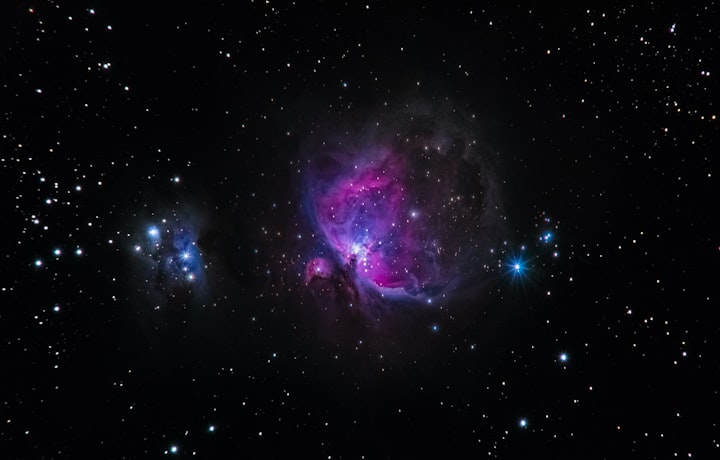Various largest objects in the universe are known
The universe is big, and there are many huge objects in it

We know that Earth is not the largest planet in the universe and that there are gas giants Jupiter and Saturn closer to us. But the Sun is also not the most massive star in space compared to some stars - it's just a dwarf star. Our galaxy, the Milky Way, isn't that big either. So who is known as a giant in space?
The largest nebula
The Tarantula Nebula is the largest and most active star-forming region known in our galaxy. She extends 1800 light years and is located in the Large Magellanic Cloud, 170,000 light years from Earth.
This is one of the most famous and active stellar "nurseries" - young stars born in their beautiful folds of gas and dust. A particularly active region is located in the center of the nebula, in cluster R136.
The largest galaxies
The largest galaxy known to date is IC 1101, and recent observations indicate that it is about 5.6-6 million light years in size. For comparison: the Milky Way is only 100,000 light-years across. If we put IC 1101 where the Milky Way is now, its edge would reach our neighbor Andromeda galaxy.
IC 1101 is in the constellation Virgo, with more than 100 trillion stars. The distance from Earth to the space giant is 1.04 billion light years.
The largest exoplanet
When the GQ Lupi b object was first discovered in 2005, astronomers were very surprised. The planet revolves around a distant young star - it is 2.5 times larger than the distance between Pluto and the Sun. This companion star looks like both a planet and a brown dwarf. Unimaginable: What are the largest objects in the universe and where are they?
The universe is big and full of huge objects. Planets, stars, galaxies, and their star clusters stretch to unimaginable distances. High technology talks about the largest of them.
We know that Earth is not the largest planet in the universe, there are gas giants Jupiter and Saturn closer to us. But the Sun is also not the most massive star in space compared to some stars - it's just a dwarf star. Our galaxy, the Milky Way, isn't that big either. So who is known as a giant in space?

The largest nebula
The Tarantula Nebula is the largest and most active star-forming region known in our galaxy. She extends 1800 light years and is located in the Large Magellanic Cloud, 170,000 light years from Earth.
This is one of the most famous and active stellar "nurseries" - young stars born in their beautiful folds of gas and dust. A particularly active region is located in the center of the nebula, in cluster R136.
The largest galaxies
The largest galaxy known to date is IC 1101, and recent observations indicate that it is about 5.6-6 million light years in size. For comparison: the Milky Way is only 100,000 light-years across. If we put IC 1101 where the Milky Way is now, its edge would reach our neighbor Andromeda galaxy.
IC 1101 is in the constellation Virgo, with more than 100 trillion stars. The distance from Earth to the space giant is 1.04 billion light years.
The largest exoplanet
When the GQ Lupi b object was first discovered in 2005, astronomers were very surprised. The planet revolves around a distant young star - it is 2.5 times larger than the distance between Pluto and the Sun. This companion star looks like both a planet and a brown dwarf
Subsequent observations didn't clarify the situation, but today scientists think GQ Lupi b has a radius of about 3.5 times greater than Jupiter. This means that if this is an exoplanet, then it is the largest ever discovered.
The biggest star
When it comes to the largest stars, nothing is easy. Most stars are variable, which means that they change their brightness, radius, and effective temperature almost throughout their lifetime. Until 2020, the largest star is UY Shield (UY Scuti), a supergiant with a radius about 1700 times that of the Sun. If UY Scuti were placed at the center of the solar system, its edge would be just beyond the orbit of Jupiter. The gas and dust emanating from the star would extend even farther - beyond the orbit of Pluto.
According to the updated data, however, she is not the biggest star, a title held by Stephenson 2-18 from 2020 inwards.
It is a bright red supergiant or supergiant star, a member of the Stevenson 2 cluster, and one of the brightest cool supergiants It has a radius of 2,158 suns and emits light equivalent to that of 440,000 suns.
The Largest Black Holes
Supermassive black holes are thought to be at the center of every galaxy, even our own. They are millions of times more massive than the Sun, and the largest of them is TON 618. In the context of giants, this is the most impressive object of all - a black hole 66 billion heavier than the Sun.
TON 618 is located in the constellation Hounds tooth, far away from us - 10.37 billion light-years from Earth.
The largest single object
When the universe was one-tenth of its present age, 14 galaxies began interacting actively with each other. They faced the formation of the largest mass of any known gravitation ally bound space object - the proton-cluster SPT2349-56.
Eventually, it will merge into a single galaxy that will be trillions of times more massive than the Sun. By the way, SPT2349-56 was recently discovered in 2018.
Quasars are located at the centers of active galaxies and are among the brightest objects known in the universe. They radiate a thousand times the energy of the Milky Way, which contains between 20 and 400 billion stars. And in the summer of 2018, astronomers from the U.S. National Radio Astronomy Observatory found one of the brightest. This quasar is 13 billion light-years from Earth and appeared when the universe was less than 10% of its current size.
About the Creator
Many A-Sun
Where your interests lie, that's where your abilities lie.






Comments
There are no comments for this story
Be the first to respond and start the conversation.